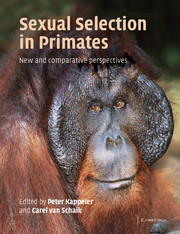Book contents
- Frontmatter
- Contents
- List of contributors
- Foreword by Robert L. Trivers
- Preface
- PART I INTRODUCTION
- PART II SEXUAL SIGNALS: SUBSTRATES AND FUNCTION
- PART III SEXUAL SELECTION IN ACTION
- PART IV DEVELOPMENT AND CONSEQUENCES
- 10 Development and sexual selection in primates
- 11 Alternative male reproductive strategies: male bimaturism in orangutans
- 12 Sexual selection and the careers of primate males: paternity concentration, dominance-acquisition tactics and transfer decisions
- 13 Sexual selection, measures of sexual selection, and sexual dimorphism in primates
- 14 Sex ratios in primate groups
- 15 Natural and sexual selection and the evolution of multi-level societies: insights from zebras with comparisons to primates
- Index
- References
13 - Sexual selection, measures of sexual selection, and sexual dimorphism in primates
Published online by Cambridge University Press: 10 August 2009
- Frontmatter
- Contents
- List of contributors
- Foreword by Robert L. Trivers
- Preface
- PART I INTRODUCTION
- PART II SEXUAL SIGNALS: SUBSTRATES AND FUNCTION
- PART III SEXUAL SELECTION IN ACTION
- PART IV DEVELOPMENT AND CONSEQUENCES
- 10 Development and sexual selection in primates
- 11 Alternative male reproductive strategies: male bimaturism in orangutans
- 12 Sexual selection and the careers of primate males: paternity concentration, dominance-acquisition tactics and transfer decisions
- 13 Sexual selection, measures of sexual selection, and sexual dimorphism in primates
- 14 Sex ratios in primate groups
- 15 Natural and sexual selection and the evolution of multi-level societies: insights from zebras with comparisons to primates
- Index
- References
Summary
INTRODUCTION
Sexual dimorphism in anthropoid primates is commonly viewed as a product of sexual selection (Clutton-Brock et al., 1977; Harvey et al., 1978; Gaulin & Sailer, 1984; Clutton-Brock, 1985; Milton, 1985; Rodman & Mitani, 1987; Kay et al., 1988; Ely & Kurland, 1989; Greenfield, 1992a, b; Plavcan & van Schaik, 1992, 1994, 1997; Ford, 1994; Martin et al., 1994; Mitani et al., 1996b; Lindenfors & Tullberg, 1998; Plavcan, 1999, 2001; Barton, 2000; Lindenfors, 2002a; Mitani et al., 2002). Yet dimorphism in anthropoids is highly variable, and is expressed not as a single character, but rather to different degrees in different traits. This naturally raises the question of whether this variation is owing to variation in the strength of sexual selection, phylogenetic effects or the action of other selective factors on the dimorphic characters. While numerous papers have examined the causes and correlates of dimorphism in anthropoids, the relative contribution of sexual selection and other factors to variation in dimorphism remains unclear.
Part of this problem lies in the way that both dimorphism and sexual selection are measured. Both of these variables are estimated with error, not only in a simple statistical sense, but also in the assumptions that are used to justify measures as appropriate for analysis. Some of these biases are obvious, while others are not. Thus, if dimorphism is poorly correlated with an estimate of sexual selection, we can legitimately ask whether dimorphism is affected by factors other than sexual selection, or whether our measures fail to capture variation in either sexual selection or the targets of sexual selection.
- Type
- Chapter
- Information
- Sexual Selection in PrimatesNew and Comparative Perspectives, pp. 230 - 252Publisher: Cambridge University PressPrint publication year: 2004
References
- 57
- Cited by

